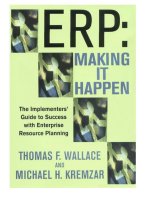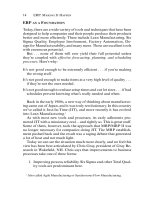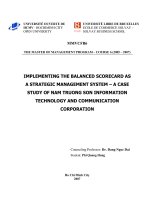The case analysis process of strategic management (2)
Bạn đang xem bản rút gọn của tài liệu. Xem và tải ngay bản đầy đủ của tài liệu tại đây (242.76 KB, 24 trang )
The Internal Environment
The Strengths and Weakness of the Firm
A Firm’s Tangible & Intangible Resources
combine with Firm’s Capabilities to create
Distinctive Competencies
Distinctive Competencies – those activities that
a firm performs better than any competing firm
The Internal Environment
The Strengths and Weakness of the Firm
Sustained Competitive Advantage – firms
that possess and exploit costly to imitate,
rare, and valuable resources & capabilities
in choosing and implementing their
strategies may enjoy a period of sustained
competitive advantage and above normal
economic profit.
The Internal Environment
The Strengths and Weakness of the Firm
Tangible Resources:
Dow Chemical’s research laboratory and
facilities
Intel’s semiconductor fabrication facilities
AT&T’s network of wire, cable, and satellites…
The Internal Environment
The Strengths and Weakness of the Firm
Intangible Resources:
Toyota’s well-known and trusted brand names,
New Season’s good reputation,
Intel’s knowledgeable and creative workforce,
Sun Microsystems’ unifying corporate culture,
Subway’s international experience with different country’s
regulations on franchising,
Norm Thompson Outfitters’ visionary leader with strong
motivation and communications skills,…
The Internal Environment
The Strengths and Weakness of the Firm
Capabilities
Emerge over time through complex interaction between
and among tangible and intangible resources.
Become stronger and more valuable strategically through
repetition and practice.
Skills and knowledge of firm’s employees, including
functional expertise (human capital)
The Internal Environment
The Strengths and Weakness of the Firm
Capabilities
Examples:
• Toyota’s efficient distribution systems - Just-in-time (JIT) delivery,
strong supplier relationships, and well-trained inventory specialists.
• L.L. Bean’s customer segmentation procedures and systems database management systems, effective market research efforts
and strong supplier relationships.
• Nike’s new product development procedures – creative workforce
and innovation-driven culture, strong leadership, and effective
market research.
The Internal Environment
The Strengths and Weakness of the Firm
Distinctive Competencies: The VRIO
Framework
Question of Value: Do a firm’s resources and
capabilities enable the firm to respond to
neutralize external threats and/or capitalize on
external opportunities?
Example: Are InFocus’ engineers and marketing staff able to
develop and sell home-based projector systems before its
competitors?
The Internal Environment
The Strengths and Weakness of the Firm
Distinctive Competencies: The VRIO Framework
Question of Rarity: Is a resource or capability currently
controlled by only a small number of competing firms?
Example: Does InFocus have the technical expertise and
market access that other firms do not have to innovate and sell
home-based projector systems?
The Internal Environment
The Strengths and Weakness of the Firm
Distinctive Competencies: The VRIO Framework
Question of Inimitability: Do firms without the resource
or capability face a cost disadvantage in obtaining or
developing it?
Example: Is it quite expensive for Toshiba to internally develop
the expertise to manufacture home-based projector systems?
The Internal Environment
The Strengths and Weakness of the Firm
Distinctive Competencies: The VRIO Framework
Question of Organization: Are a firm’s other policies
and procedures organized to support the use of its
valuable, rare, and costly to imitate resources and/or
capabilities?
Example: Are InFocus’ organizational structure and
compensation policies appropriate to support its efforts to
develop, manufacture and distribute home-based projector
systems?
The Internal Environment
The Strengths and Weakness of the Firm
Value Chain Analysis
Examines contributions of individual activities to overall
level of customer value and ultimately financial
performance.
Customer value: product differentiation, low cost, and/or
responsiveness
The Internal Environment
The Strengths and Weakness of the Firm
Value Chain Analysis
Primary Activities
Inbound Logistics
Operations
Outbound Logistics
Marketing and Sales
Customer Service
Secondary Activities
Firm Infrastructure
Human Resource
Management
Technology Development
Procurement
Primary Activities and Factors for Assessment
Inbound
Logistics
Soundness of
material and
inventory
control
systems
Efficiency of
raw material
warehousing
activities
Operations
Outbound
Logistics
Productivity of Timeliness and
equipment
efficiency of
compared to
delivery of
that of key
finished goods
competitors
and services
Appropriate
Efficiency of
automation of
finished goods
production
warehousing
processes
activities
Effectiveness
of production
control systems
to improve
quality and
reduce costs
Efficiency of
plant layout
and work-flow
design
Marketing & Sales
Customer
Service
Effectiveness of
market research to
identify customer
segments & needs
Innovation in sales
& promotion
Evaluation of
alternate
distribution
channels
Motivation and
competence of sales
force
Development of
image of quality and
a favorable
reputation
Extent of brand
loyalty among
customers
Extent of market
dominance within
the market segment
or overall market
Means to solicit
customer input
for product
improvements
Promptness of
attention to
customer
complaints
Appropriateness
of warranty and
guarantee
policies
Quality of
customer
education and
training
Ability to
provide
replacement parts
and repair service
Secondary Activities and Factors for Assessment
Firm
Infrastructure
Capability to
identify new
product market
opportunities and
potential
environmental
threats
Quality of the
strategic planning
system to achieve
corporate objectives
Coordination and
integration of all
value chain
activities
Ability to obtain
relatively low cost
funds for capital
expenditures and
working capital
Timely & accurate
information on
general and
competitive
environments
Human
Resource
Effectiveness of
procedures for
recruiting,
training, and
promoting all
levels of
employees
Appropriateness
of reward systems
Relations with
trade unions
Levels of
employee
motivation and
job satisfaction
Technology
Development
Success of R&D
activities in leading
to product and
process innovations
Quality of working
relationship between
R&D personnel and
other departments
Timeliness of
technology
development
activities in meeting
critical deadlines
Qualifications &
experience of
laboratory
technicians and
scientists
Ability of work
environment to
encourage creativity
and innovation
Procurement
Development of
alternate sources for
inputs to minimize
dependence on a
single supplier
Procurement of raw
materials on timely
basis at lowest
possible cost and at
acceptable levels of
quality
Development for
criteria for lease-vs.buy decisions
Good, long-term
relationships with
suppliers
The Internal Environment
So strengths and weaknesses are based on how well
value chain activities are performed
Resources and capabilities determine the performance
of value chain activities. Look at…
Corporate culture and Leadership
Marketing management issues
Financial management issues
R&D management issues
HR management issues
Operations management issues
Information systems management issues
Stakeholder management issues
The Internal Environment
The Strengths and Weakness of the Firm
Is a resource or capability…
Valuable?
No
Yes
Yes
Yes
Rare?
-No
Yes
Yes
Costly to
Imitate?
--No
Yes
Exploited
By Firm?
No
Yes
Competitive
Implications
Comp. Disadv.
Comp. Parity
Temp Comp. Adv.
Sustained Comp.
Adv.
The Internal Environment
Life Expectancy of Sustained Competitive
Advantage
Length of Innovation Cycle the faster the cycle, the easier it is to
take away competitive advantage
Example: New generation of cameras born about every 10 months
Number of Dimensions of Customer Value the more dimensions,
the easier it is for competitors to find ways of eroding competitive
advantage
Example: An I-beam is an I-beam, but an automobile comes in
many shapes, sizes, etc.
The Internal Environment
Life Expectancy of Sustained Competitive
Advantage
Switching Costs Between Rivals: the easier it is to switch, the
easier it is to take away competitive advantage
Example: Difficulty in switching between office systems
management service providers versus ease of switching between
office supplies provider.
Internal Factor Analysis Summary
Internal Factors
Weight
Rating
Weighted
Score
Strengths
Weaknesses
Total
1.00
????
Comments
Internal Factor Analysis Summary
Same basic procedure as the External Factor
Analysis Summary.
See page 101 and 102 of the text for more
discussion of the IFAS.
Internal Scanning
Example: Proctor & Gamble (circa 1992)
Resources
Research and Development
P&G invests 4% of worldwide sales in research and development ahead of most of
its global competitors. In 1997-98 this amounted to $1.5 billion.
P&G has a world class, global research and development organization, with over
7,500 scientists working in 22 research centers in 12 countries around the
world.
Innovative Workforce
P&G holds more than 24,000 active patents worldwide, and on average, receives
about 3,800 more patents per year. This makes P&G among the world's largest
holders of U.S. and global patents, putting it on a par with Intel, Lucent and
Microsoft.
Proctor & Gamble
Capability
Directed growth and maximized chances of success by leveraging considerable
technical competencies across product categories and national boundaries.
Competencies
A deep understanding of consumers, their habits and product needs.
The ability to acquire, develop and apply technology across P&G's broad array of
product categories.
The ability to make "connections" between consumers' wants and what technology
can deliver
Strategic Issue
Market research revealed brand loyal consumers were paying $725/year more than
families buying private-label or store brands.
Need new strategy to reduce costs and better meet consumer demand
Factors for Assessment:
Technology Development (R&D): was the initiator of product development,
produced technologically superior productS
Firm Infrastructure: Relationship between R&D and Marketing & Sales -Marketing released new products under new brand names
Marketing & Sales: complex with 17 pricing brackets for 34 product
categories
Manufacturing: Capacity utilization averaged about 55%, with excess needed
to handle bubble demand brought on by occasional price wars
Outbound Logistics: heavily paper-laden
Methods for Assessment:
Organizational Perspective:
Superior products no longer matched needs of marketplace, particularly in
developing markets.
Devolve products – less technology, lower price.
Put marketing research in charge of setting initial new product development
guidelines.
Improve internal processes for product development.
Methods for Assessment:
Customer value:
Brand equity for existing brands is high (e.g. Ivory). Release new
developments under existing brand names rather than creating new ones.
Improve customer value by strengthening brand relationship to new products.
Financial Perspective:
Outbound logistics unnecessarily expensive. Work with industry stakeholders,
including competitors, to simplify delivery system through standardization and
computerization. Improves industry’s profitability.
Reduce number of brands and product lines. Simplifies manufacturing
process and eliminate slack in capacity utilization. Better ROA, and hopefully
better P/E ratio.









